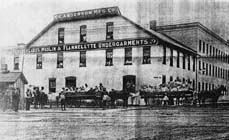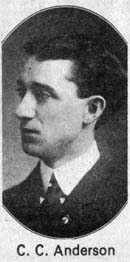January 24, 1978


Picture #1 – C.C. Anderson Manufacturing Co.
Picture #2 – C.C. Anderson
Before memories are erased and historical notes destroyed, I should tell readers about the garment manufacturing plants that existed in Fostoria in the early days of this century.
Sept. 1904, at the corner of Wood and North Streets, C.C. Anderson, Carl as he was generally known, established his C.C. Anderson Manufacturing Co., to make muslin and flannelette undergarments.
According to early records, the plant was not small when it opened, but in 1905 the business had grown to such extent it was necessary to add a large addition, and a similar plant was built at Findlay, Ohio.
The Anderson Mfg. Co. had the distinction of being the largest cutter of muslin and flannelette garments in the world.
Historical records of that day had this to say about Fostoria’s new industry. ..”The buildings are roomy, airy, and women who do the work have every comfort of the parlor. Women are taken into this establishment, taught how to sew and paid while they are learning. Three hundred people are employed in each factory, a force that is not only capable, but which has a genuine interest in the welfare of the business, because of the square deal given them by those at the head of the concern. The company is now arranging to erect plants at McComb and Kenton, Ohio, in order to meet the demand made by the public for its products”.
Anderson, who was rated as Fostoria’s most influential and honored citizen at that time was born in Bluffton, Ohio, Dec. 2, 1877. He was educated in the common school at Fremont, Ohio…started life as a newspaper vender, later filling clerical positions in the offices of the L.S. and M.S. and L.E. and W railroads.
Later he became a traveling salesman for the A.H. Jackson Mfg. Co., a manufacturer of undergarments, which was a competitor to him when he organized C.C. Anderson Mfg. Co.
The accompanying photo shows the C.C. Anderson Mfg. Co. factory as it appeared in 1904. There are still some Fostorians who will remember it, as well as the story being told. Others may remember that the building later housed the Allen Motor Car Co., and still later The Hoyt Seed Co., which was located there just prior to the purchase by the YMCA for expansion purposes, at which time the building was demolished.
Anderson’s meteoric rise to fame was cut short by an early death at age 35. He was Mayor of Fostoria in 1905. Later he became Ohio Congressman for the 13th district. On Oct. 1, 1912, Anderson with other associates was campaigning for reelection to that office, by visiting villages in this area. Returning to Fostoria on the New Riegel road that night, the car in which they were travelling had a tire blowout which put them in the ditch, overturned, killing Anderson and injuring others.
The accident happened at a curb in the road, approximately one-half mile from the Fostoria-Tiffin road (now Route 18)
The Anderson family lived at 347 W. Tiffin Street, where private funeral services were held, with Clement G. Martin, D.D. pastor of the presbyterian church officiating. Hundreds of people viewed the remains at the Aire chapel. Burial was at Oakwood Cemetery, Fremont.
At the same spot where Anderson was killed, in November, 1954, another car accident resulted in the death of Melvin Leedy, a local young man, home on furlough from the Navy.
At the time of Anderson’s death he planned to attend the National Democratic Convention in Chicago.
Anderson’s popularity is understood when all of his associations are divulged. In addition to being Mayor of Fostoria, he was president of the local Board of Trade, president of Fostoria Hospital Association, a director of Seneca Wire and Mfg. Co., also The Blue Mfg. Co., president of The Mitchel Reversible Window Co., Fremont, president of The Fostoria Baby Carriage Storm Shield Co.
He was associated with lodges…BPOE, K of P, Masonic, Jr. OUAM.
In later years the A.H. Jackson Mfg. Co., with which Anderson had been associated earlier, setup a plant in Fostoria, presumably after Anderson’s death. It was located in the building at corner of North and Potter streets, now occupied by Gold Bond Furniture.
The A.H. Jackson Co. too manufactured muslin and flannelette undergarments. They manufactured on the second floor and had a retail store on the first floor.
I am sure there are still a few women living in Fostoria who worked there.
Like the writer of this column, the readers may ponder the question…what happened to all the local industry that existed in Fostoria at the turn of the century?…what has become of the native leadership that existed then, and spurred the growth of Fostoria in the era?
Someday, I may write my theoretical answers to those questions.